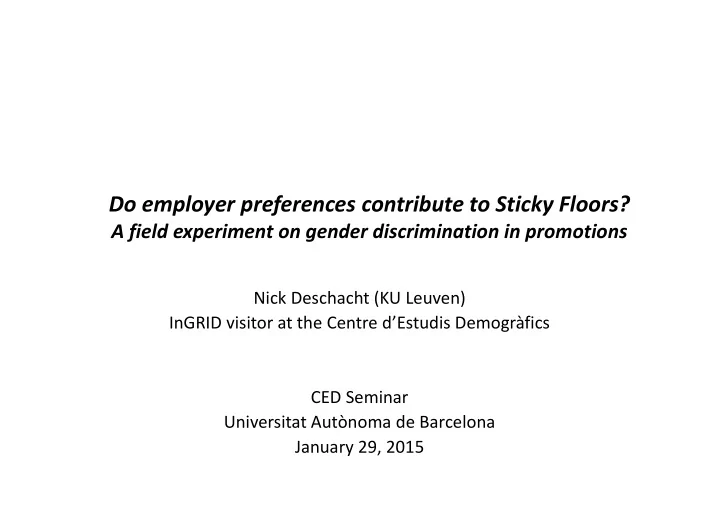

Do employer preferences contribute to Sticky Floors? A field experiment on gender discrimination in promotions Nick Deschacht (KU Leuven) InGRID visitor at the Centre d’Estudis Demogràfics CED Seminar Universitat Autònoma de Barcelona January 29, 2015
Do employer preferences contribute to Sticky Floors? � Joint research with Stijn Baert (Ghent University & IZA) Ann-Sophie De Pauw (IESEG School of Management, LEM-CNRS) � Glass Ceilings research looks at top positions (cfr. quota). Sticky Floors research looks at the lower career levels. This research is about young professionals ( � Sticky Floors). 2
How to determine the role of ‘employer preferences’? � We know that women lower wages and are less likely to be promoted. But that doesn’t prove that there is discrimination. Basically there are three types of reasons for gender gaps: 1. Productivity differences 2. Women don’t want to be promoted, they are less ambitious 3. Discrimination � The standard approach to measure discrimination is to use regression analysis to control for productivity and ambition (discrimination is then supposed to be the residual): ���� � = � � + � � ��� � + � � ������������ � + � � �������� � + � � The problem is that many characteristics are difficult to observe (e.g. ability, motivation, ...) � omitted variable bias. 3
How to determine the role of “employer preferences”? � Experiments avoid omitted variable bias by randomly assigning treatment (e.g. the effect of a medical treatment). � What would be the ideal experiment to estimate the causal effect of gender on career outcomes? � A feasible alternative is a “paired-CV experiment” or “correspondence study” (Bertrand & Mullainathan, AER 2004) � Two fictitious job applications are sent to real job openings. � These applications differ only by the gender of the applicant. � By monitoring the subsequent call back, unequal treatment is identified. � Omitted variable bias is not an issue. � We are the first to use this method to study the relation between gender and promotions. 4
Method � We randomly selected 576 vacancies for jobs � From the database of the Public Employment Agency of Flanders. � Jobs targeting Bachelors in Business Administration and Masters in Business Economics. � Jobs requiring at most 5 years of work experience. � Based on the information in the vacancy we scored each vacancy on two promotion dimensions: 1. Occupational level: A job at a higher ISCO level implies a promotion. 2. Job authority: If the new job holds supervision authority it implies a promotion. � We then sent out 2 applications to each of the 576 vacancies. 5
The method in practice � We cannot send the exact same CVs because that would be suspicious: CURRICULUM VITAE CURRICULUM VITAE TYPE A TYPE B 5 YEARS OF WORK 5 YEARS OF WORK EXPERIENCE IN EXPERIENCE IN JUNIOR POSITION JUNIOR POSITION STIJN VAN LANCKER ELKE DE VOS Vacancy N � Types A and B are identical regarding education, experience, language and ICT skills, driver’s license, nationality, ...). � 6 They differ in the details (e.g. lay-out).
The method in practice CURRICULUM VITAE CURRICULUM VITAE TYPE A TYPE B 5 YEARS OF WORK 5 YEARS OF WORK EXPERIENCE IN EXPERIENCE IN JUNIOR POSITION JUNIOR POSITION ELKE DE VOS STIJN VAN LANCKER Vacancy N + 1 We also added a short cover letter with the same information (Where was the vacancy found? + Reference to earlier work experience? + Hope to be invited for a job interview). 7
The method in practice � We created an e-mail address and a telephone number for each of our ficticious applicants with a simple voice mail message (we never answered the phone directly). � All the job applications were sent by e-mail. The second application was sent 24 hours after the first one. � Positive call back � Invitation for a job interview � Request for more information or proposal for another job Negative call back � Rejection � No reaction 30 days after the deadline for applications � In the case of positive call back we e-mailed asap to withdraw the application. 8
Ethics? Criticisms: � The employers don’t know they are part of an experiment. � It costs time and money for the employers. � Researchers also have personal interests. Defense: � The social costs of discrimination are greater than the individual costs for the employer. � It is impossible to do this with informed consent. � The costs for employers were kept to a minimum. � We only report aggregated results. No legal actions against discriminators. � Our research was approved by an ethical committee. 9
Results (1) ���������� ������������������������������������� ��������������������������� ���������� ���������� ��������������������������� ��������������������������� ���������� ���������� ���������� ���������� ���������� ���������� ������� ���� ������ ����� ����� ����� ����� �������� ����� ����� ���� ���� ���� ���� ���� ��������������������������������������������������� ��������������������������������������������������� ��������������������������������������������������� ��������������������������������������������������� ���������� ����� � � � ���! ���! ���! ���! ��! "�#$�������� ����� %� � ��&�'' ��&�'' ��&�'' ��&�'' !�� ���������������������������������������������� ���������������������������������������������� ���������������������������������������������� ���������������������������������������������� (�����$����) �!�&� ��� � ���� ���� ���� ���� ��*% +������$����) ���� ���� ���� ���� ��,& ���� ���� ����-��-��������������������-��������������#�����$�������������������$��������)��������'''���-���������#��������������$�������#���������������.�''���� �$��&����#������������������-�'�����$��������#���������������� 10
Recommend
More recommend